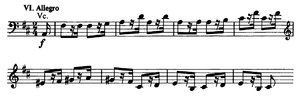1st Serenade (Brahms)
The Serenade Nr. 1 D-Op. 11 is the result of incoming employment of Brahms with Serenaden Mozart and Sinfonien Haydn . It was composed at the end of the 1850s and partially overlaps with that of its sister work Serenade No. 2 in A major, Op. 16. At the same time, it partially falls into the phase in which Brahms was revising his difficult creative 1st piano concerto .
Origin and premiere
Johannes Brahms worked from September 1857 to 1859 from September to December at the Fürstenhof in Detmold as a concert pianist, conductor of the court choir and piano teacher for Princess Friederike. There he studied symphonies by Joseph Haydn and had his friend Joseph Joachim send him scores of Wolfgang Amadeus Mozart's serenades. The first serenade “1857-8” was based on a handwritten catalog of works by Brahms. In September 1858 he played a preliminary version for friends Clara Schumann , Julius Otto Grimm and Joseph Joachim in Göttingen , which initially comprised four movements (structurally corresponding to the later movements 1 to 4, however, only partially). Joachim premiered the work in six movements on March 28, 1859 in Hamburg . A nonet (a flute, two clarinets, a horn, a bassoon and strings) could be identified as the instrumentation at that time (not an octet , as earlier biographers such as Max Kalbeck assume).
In December 1859 Brahms asked Joachim music paper with the intention of "turning the work into a symphony". The orchestration took place until the end of January 1860. However, the autograph shows that Brahms titled the work “Serenade” at the beginning of the orchestration, then added the prefix “Symphony-”, but deleted it again in February 1860. The first performance of the definitive final version took place on March 3, 1860 in the Royal Court Theater in Hanover , again under the direction of Joseph Joachim. In the same year the work was published by Breitkopf & Härtel in Leipzig . In the following years, however, the composition was reluctant to gain acceptance.
Instrumentation
The score provides for the following scoring : two flutes , two oboes , two clarinets , two bassoons , four horns , two trumpets , timpani and strings .
Structure and characteristics
The performance of the six-movement work, which is characterized by a cheerful mood, is around 45 minutes. Proportions - the first three movements last a good 30 minutes, the next three just under 15 minutes - and the compositional work-through with partly symphonic features in the first movements, while movements 4 to 6 are more serenade-typical, leave the symphony composition temporarily planned by Brahms guess.
- I. Allegro molto . The first theme in D major of the movement following the sonata form is related to the final theme of Joseph Haydn's 104th Symphony . The development shows syncopations and triplet formations typical for Brahms .
- II. Scherzo, Allegro non troppo . Designed as a da capo form ( scherzo with trio). The main theme, intoned in unison, is in D minor and resembles that of the scherzo in Brahms' later 2nd piano concerto .
- III. Adagio non troppo . Broad-based sonata form (250 bars), the main theme of the very vocal movement with artful thematic work is in B flat major.
- IV. Menuetto . Da capo form with Menuetto I (G major) and Menuetto II (G minor). In its chamber music composition and thematic formation, this movement is based heavily on classical models.
- V. Scherzo, Allegro . Da capo form (scherzo with trio) with Beethoven echoes, the first theme in D major is intoned by the horns.
- VI. Rondo, Allegro . Rondo shape in the sequence AB-A'-C-B'-A ''. The main theme, moving like a march, is in D major.
Reconstruction and reception
The Argentine conductor and composer Jorge Rotter published in 1987 “a speculative reconstruction of the lost original line-up for nonet ” (1.0.2.1 - 1.0.0.0 - strings: 1.0.1.1.1). The composer Horst Lohse wrote four commentaries and an interlude ( Brahms reflections , premiered in Leverkusen in 1989 in combination with Brahms' Serenade).
Other chamber music versions were created by Alan Boustead (1987, for nonet: 1.0.2.1 - 1.0.0.0 - strings: 1.0.1.1.1) and Chris Nex (for decett: 1.1.1.1 - 1.0.0.0 - strings: 1.1.1.1.1 ).
literature
- Wulf Konold (Ed.): Lexicon Orchestermusik Romantik. A-H . Piper / Schott, Mainz, 1989, ISBN 3-7957-8226-0 (Schott), pp. 91-93.
- Wolfgang Sandberger (Ed.): Brahms Handbook , joint edition JB Metzler'sche Verlagsbuchhandlung and Bärenreiter, 2009, ISBN 978-3-476-02233-2 (Bärenr.), Pp. 496–501.
- Pocket score, Edition Eulenburg No. 855 (no year) with a foreword by Wilhelm Altmann .
Individual evidence
- ↑ Christiane Mitlehner on musiktext.de ( Memento from March 4, 2016 in the Internet Archive )
- ^ Simon Aldrich, The Clarinet BBoard
Web links
- 1. Serenade (Brahms) : Sheet music and audio files in the International Music Score Library Project
- First editions, brahmsinstitut.de





